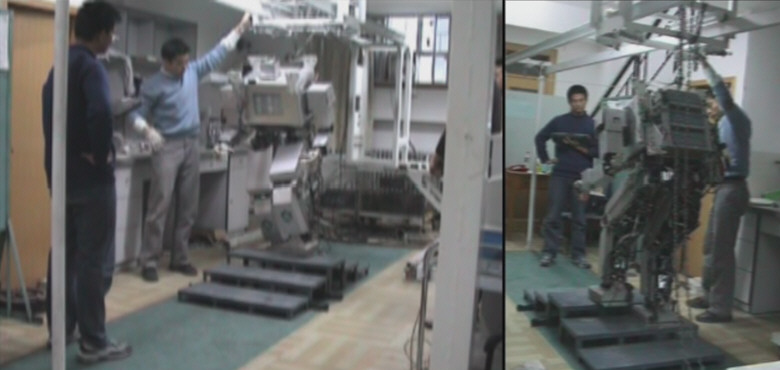From Rii
m |
|||
| Line 6: | Line 6: | ||
[[image:note_bulb.png|text-bottom|12px]] This work was done when Dr. Kai Xu was with [http://ime.pim.tsinghua.edu.cn/research/research33.html the Robotics & Automation Lab, Department of Precision Instrument and Mechanology, Tsinghua University] | [[image:note_bulb.png|text-bottom|12px]] This work was done when Dr. Kai Xu was with [http://ime.pim.tsinghua.edu.cn/research/research33.html the Robotics & Automation Lab, Department of Precision Instrument and Mechanology, Tsinghua University] | ||
| - | [[image:Research_THBIP2000.jpg|border]] | + | [[image:Research_THBIP2000.jpg|border|center]] |
That was a China’s systematic effort developping humanoid technology. The THBIP-I robot had 27 independent DoFs with a real-time distributed hierarchical control structure coordinating with the servo control, gait generation, gesture sensing, vision tracking and task planning subsystems. It was able to conduct autonomous walking using its on-board battery and manipulate small objects. | That was a China’s systematic effort developping humanoid technology. The THBIP-I robot had 27 independent DoFs with a real-time distributed hierarchical control structure coordinating with the servo control, gait generation, gesture sensing, vision tracking and task planning subsystems. It was able to conduct autonomous walking using its on-board battery and manipulate small objects. | ||
| Line 13: | Line 13: | ||
The following video clips show walking experiments of the THBIP-I humanoid robots using onboard batteries from year 2003. | The following video clips show walking experiments of the THBIP-I humanoid robots using onboard batteries from year 2003. | ||
| - | {| | + | {|style="margin: 1em auto 1em auto;" |
|align="center"|'''8 seconds per step''' | |align="center"|'''8 seconds per step''' | ||
|align="center"|'''6 seconds per step''' | |align="center"|'''6 seconds per step''' | ||
Revision as of 12:51, 21 February 2013
Gait Generation and System Integration for the THBIP-I Humanoid Robot
August 2000 to September 2003
![]() This work was done when Dr. Kai Xu was with the Robotics & Automation Lab, Department of Precision Instrument and Mechanology, Tsinghua University
This work was done when Dr. Kai Xu was with the Robotics & Automation Lab, Department of Precision Instrument and Mechanology, Tsinghua University
That was a China’s systematic effort developping humanoid technology. The THBIP-I robot had 27 independent DoFs with a real-time distributed hierarchical control structure coordinating with the servo control, gait generation, gesture sensing, vision tracking and task planning subsystems. It was able to conduct autonomous walking using its on-board battery and manipulate small objects.
Dr. Xu was involved in mechanism design, gait generation algorithms, kinematics modeling, dynamics and vibration modeling, experimental validation, formulating real-time gesture compensation, task planning designed, etc. He also served as a coordinator, organzing meetings, experiments, progress documentation, etc.
The following video clips show walking experiments of the THBIP-I humanoid robots using onboard batteries from year 2003.
| 8 seconds per step | 6 seconds per step |
